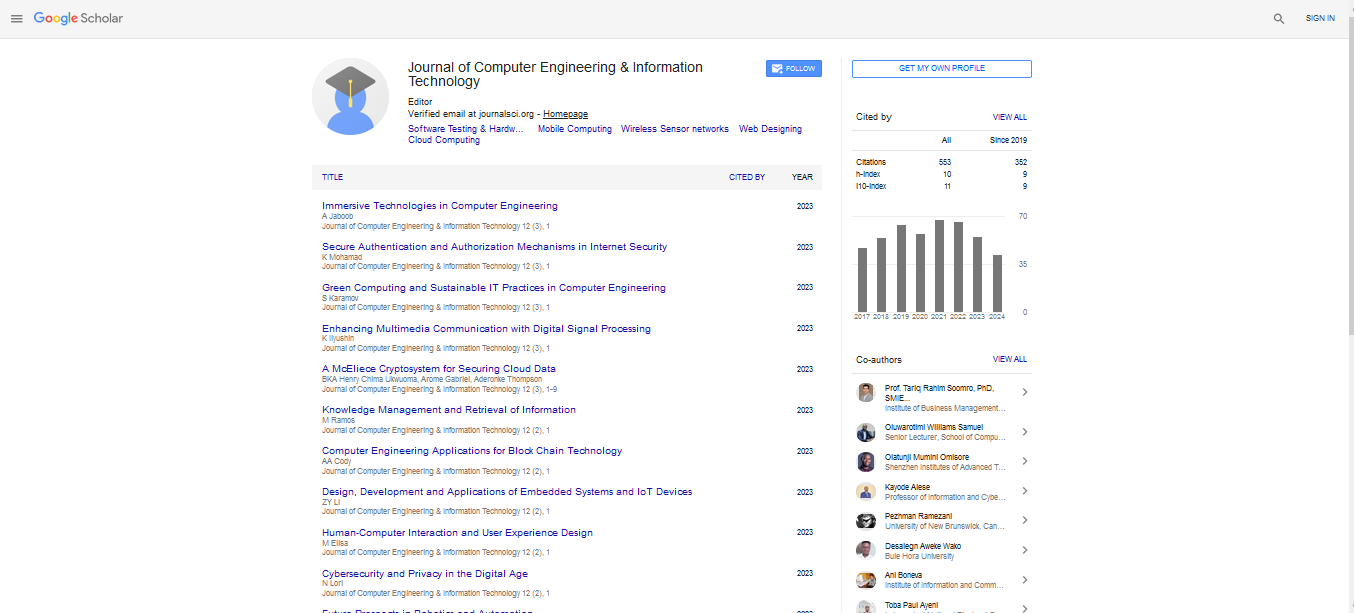Editorial, Jceit Vol: 14 Issue: 2
Zero Trust Architecture: Rethinking Cybersecurity for a Perimeterless World
Durga Verma*
TIFAC CORE in Cyber Security, Amrita School of Engineering, Amrita Vishwa Vidyapeetham, Coimbatore, Tamil Nadu, India
- *Corresponding Author:
- Durga Verma
TIFAC CORE in Cyber Security, Amrita School of Engineering, Amrita Vishwa Vidyapeetham, Coimbatore, Tamil Nadu, India
E-mail: v_durga@gmail.com
Received: 01-March-2025, Manuscript No jceit-25-169324; Editor assigned: 4-March-2025, Pre-QC No. jceit-25-169324 (PQ); Reviewed: 20-March-2025, QC No jceit-25-169324; Revised: 27-March-2025, Manuscript No. jceit-25-169324 (R); Published: 31-March-2025, DOI: 10.4172/2324-9307.1000345
Citation: Durga V (2025) Zero Trust Architecture: Rethinking Cybersecurity for a Perimeterless World. J Comput Eng Inf Technol 14: 345
Introduction
As the cyber threat landscape continues to evolve, traditional security models built around a trusted network perimeter are rapidly becoming obsolete. The increasing adoption of cloud services, mobile workforces, and Internet of Things (IoT) devices has blurred the lines of organizational boundaries, making it harder to define what is "inside" or "outside" a secure network. In this new environment [1], Zero Trust Architecture (ZTA) has emerged as a transformative cybersecurity model, replacing implicit trust with “never trust, always verify.”
Zero Trust challenges long-standing assumptions about network trust and redefines how organizations secure access to systems, applications, and data. Rather than focusing on defending a perimeter, Zero Trust enforces continuous verification, strict access controls, and adaptive authentication across the board. It is not just a technology, but a security philosophy whose time has come.
What Is Zero Trust Architecture?
Zero Trust Architecture is a security framework that assumes no implicit trust for any user, device, or system—whether inside or outside the network. Every access request is treated as potentially malicious and must be authenticated, authorized, and encrypted in real-time [2].
Key principles of ZTA include:
- Least privilege access: Users are granted only the minimum level of access required.
- Micro-segmentation: Network resources are divided into small zones to contain breaches.
- Continuous monitoring: Security doesn't end at login—user behavior is continuously evaluated.
- Device health verification: Devices must meet security requirements to access resources [3].
The U.S. National Institute of Standards and Technology (NIST) has outlined ZTA as a recommended framework for modern cybersecurity, emphasizing it as a strategic response to escalating cyber threats.
Why Zero Trust Is Essential Today
Zero Trust is not a theoretical concept—it is a necessary response to today’s digital reality. The rise of remote work, hybrid cloud environments, and sophisticated cyberattacks has exposed the weaknesses of perimeter-based security.
According to IBM’s 2024 Cost of a Data Breach Report, organizations with a mature Zero Trust strategy saved an average of $1.76 million compared to those without it. The 2021 SolarWinds attack, which exploited trusted network paths, highlighted the critical need for architectures that assume breach and minimize trust across every layer.
Moreover, with regulations like GDPR, HIPAA, and CCPA, organizations must ensure data protection and auditability at every access point—making Zero Trust not just a best practice, but a compliance necessity.
Implementation Challenges and Considerations
While Zero Trust offers significant advantages, adopting it is not without hurdles:
- Cultural Resistance: Moving away from traditional "castle-and-moat" models requires significant mindset shifts across IT and executive teams [4].
- Complex Integration: Implementing Zero Trust across legacy systems, cloud platforms, and mobile environments demands thoughtful planning and technology alignment.
- Performance Trade-offs: Continuous verification and encryption can introduce latency if not optimized correctly.
- Skill Gaps: Many organizations lack in-house expertise to architect and manage a full Zero Trust environment.
To succeed, organizations must adopt a phased, risk-based approach, starting with high-value assets and expanding coverage over time.
The Future of Cybersecurity Is Zero Trust
Major technology providers and governments are embracing Zero Trust as the future of cybersecurity. Microsoft, Google, and Cisco have developed comprehensive ZTA frameworks and products. The U.S. federal government has mandated Zero Trust adoption through executive orders, reinforcing its importance in national cybersecurity strategy [5].
Emerging trends such as AI-driven threat detection, identity-based access, and behavioral analytics are making Zero Trust smarter and more dynamic. With cyberattacks becoming more automated and persistent, Zero Trust offers a proactive, adaptive defense mechanism that evolves alongside threats.
Conclusion
Zero Trust Architecture is not just another buzzword—it represents a profound shift in cybersecurity thinking. By eliminating implicit trust and enforcing rigorous access control, ZTA builds resilience into the very fabric of digital operations. As organizations increasingly operate in perimeterless environments, Zero Trust is no longer optional—it is essential.
While implementation may be complex, the long-term benefits of reduced risk, improved compliance, and operational agility make it a strategic imperative for the modern enterprise. In a world where threats are constant and trust is a vulnerability, Zero Trust is the most trustworthy defense we have.
References
- Gartner (2023) Magic Quadrant for Full Life Cycle API Management.
- Postman (2024) The State of API Integration 2024 Report.
- Apigee (2023) API Management Best Practices.
- MuleSoft (2023) What is API Management?
- ProgrammableWeb (2024) API Security Challenges and Trends.
Indexed at, Google Scholar, Crossref
Indexed at, Google Scholar, Crossref
Indexed at, Google Scholar, Crossref
Indexed at, Google Scholar, Crossref
 Spanish
Spanish  Chinese
Chinese  Russian
Russian  German
German  French
French  Japanese
Japanese  Portuguese
Portuguese  Hindi
Hindi 